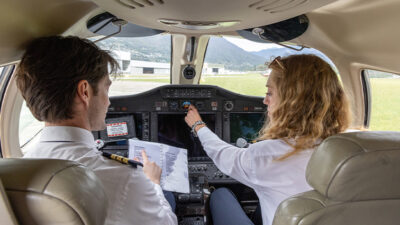Why You Need a “Business Aircraft Use Policy”

In today’s era of IS-BAO, most flight departments have a well-defined and documented Flight Operations Manual, which clearly outlines the safe and efficient operation of the aircraft.
But many companies don’t have a Business Aircraft Use Policy. Here’s how one can benefit your flight department and company.
1. It Boosts Utilization
Many companies unintentionally underutilize their business aircraft.
When business is tough, one of the first things done is to reduce flight hours. And when usage decreases, aviation costs go up, as measured on a “total cost-per-flight-hour” basis.
To get the lowest total cost per hour, increase your flight hours. Basic math tells us that when the denominator of a fraction goes up (in this case, flight hours), the value of the whole fraction (total cost per flight hour) goes down.
A Business Aircraft Use Policy takes the guessing away. It provides the guidelines under which the aircraft are to be used, which can actually result in an increase in your flight hours.
2. It Clarifies Who Can Use the Aircraft and How
A well-written Business Aircraft Use Policy designates Authorized Users of the company aircraft. It’s generally the chairman, CEO, president and senior executive team members. Often, business unit executives are on the list as well.
The Use Policy outlines procedures for requesting and authorizing the aircraft, and how to resolve scheduling conflicts.
It enables the Aviation Director (or designee) to request that passengers adjust their time schedules. This maximizes efficiency, provided travelers have schedule flexibility.
The Aviation Director may also combine some flights to avoid deadhead activity. Addressing these situations ahead of time takes the flight department out of the role of “traffic cop” so they can focus on the safe operation of the aircraft.
3. It Specifies Supplemental Lift Usage
If all aircraft are being utilized or are out of service for maintenance, the flight department may need to go off-fleet and charter an aircraft to satisfy a trip request.
Under no circumstances should anyone outside of Aviation be authorized to make charter selection decisions. The Use Policy should make it clear that if a charter aircraft is necessary, the Flight Department has sole authority to select the provider.
4. It Provides Business Continuity
To ensure the uninterrupted operation of the company in the event of a major disruption or catastrophe, care should be taken to define clear business continuity provisions.
Typical business continuity provisions within a Use Policy include the following limitations:
- Number of executives who may travel together on the same aircraft
- Specific executives (by position) who may not travel together on the same aircraft
- Number of board members who may travel together on the same aircraft
- Number of executives (VP and above) from the same business unit who may travel on the same aircraft
- Total number of employees (any level) who may travel on the same aircraft
This is a case of where the role of the flight department has changed from “transportation provider” to “strategic business partner.”
5. It Covers a Myriad of Other Important Considerations
There is a wide range of other uses of corporate aircraft and the Use Policy must address them all, such as use of company aircraft:
- By non-employee members of the Board of Directors
- By senior executives to attend meetings of outside boards of directors
- By senior executives to participate in events as representatives of the company
There are further considerations for use of company aircraft that must be addressed in the Use Policy, such as personal use of company aircraft by senior executives (definitely on the decline), imputation of income by executives for non-business flights taken, use of corporate aircraft by government officials and proxy calculations of aircraft usage.
A Use Policy Needs Stakeholder Input & Ownership
A Business Aircraft Use Policy will serve a company well from multiple perspectives. To be effective, the Use Policy needs to be developed with input from all key stakeholders in the company.
Very importantly, you need to have the support of the company’s CEO and Board of Directors. Without that, the Use Policy will have no teeth.

Gray Stone Advisors combines their experience both in leading businesses as well as business aviation operations to provide flight department leaders with proven strategies for excellence.
https://www.graystoneadvisors.com/
© 2024 Gray Stone Advisors. All Rights Reserved.
Next ArticleRelated Posts

Safety in Numbers: Trends in Aviation Accidents and Incidents
Every accident is preventable; the problem is that we don’t know how to prevent it until after the accident happens. However, what we can do as an industry is honor the anguish of each event by sharing the information, the mistakes and the outcomes to improve safety for everyone.

Is ChatGPT Ready To Analyze My SMS Portal’s Safety Reports?
While industry experts continue to design the next-gen AI-backed SMS software solution, safety managers can use ChatGPT to help them treat safety issues, audit findings and classify hazards contained in their SMS reporting.

